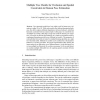Free Online Productivity Tools
i2Speak
i2Symbol
i2OCR
iTex2Img
iWeb2Print
iWeb2Shot
i2Type
iPdf2Split
iPdf2Merge
i2Bopomofo
i2Arabic
i2Style
i2Image
i2PDF
iLatex2Rtf
Sci2ools
ECCV
2008
Springer
2008
Springer
Multiple Tree Models for Occlusion and Spatial Constraints in Human Pose Estimation
Abstract. Tree-structured models have been widely used for human pose estimation, in either 2D or 3D. While such models allow efficient learning and inference, they fail to capture additional dependencies between body parts, other than kinematic constraints between connected parts. In this paper, we consider the use of multiple tree models, rather than a single tree model for human pose estimation. Our model can alleviate the limitations of a single tree-structured model by combining information provided across different tree models. The parameters of each individual tree model are trained via standard learning algorithms in a single tree-structured model. Different tree models can be combined in a discriminative fashion by a boosting procedure. We present experimental results showing the improvement of our approaches on two different datasets. On the first dataset, we use our multiple tree framework for occlusion reasoning. On the second dataset, we combine multiple deformable trees f...
Computer Vision | ECCV 2008 | Individual Tree Model | Multiple Tree Models | Single Tree Model | Single Tree-structured Model | Tree-structured Models |
Related Content
| Added | 15 Oct 2009 |
| Updated | 15 Oct 2009 |
| Type | Conference |
| Year | 2008 |
| Where | ECCV |
| Authors | Greg Mori, Yang Wang 0003 |
Comments (0)

